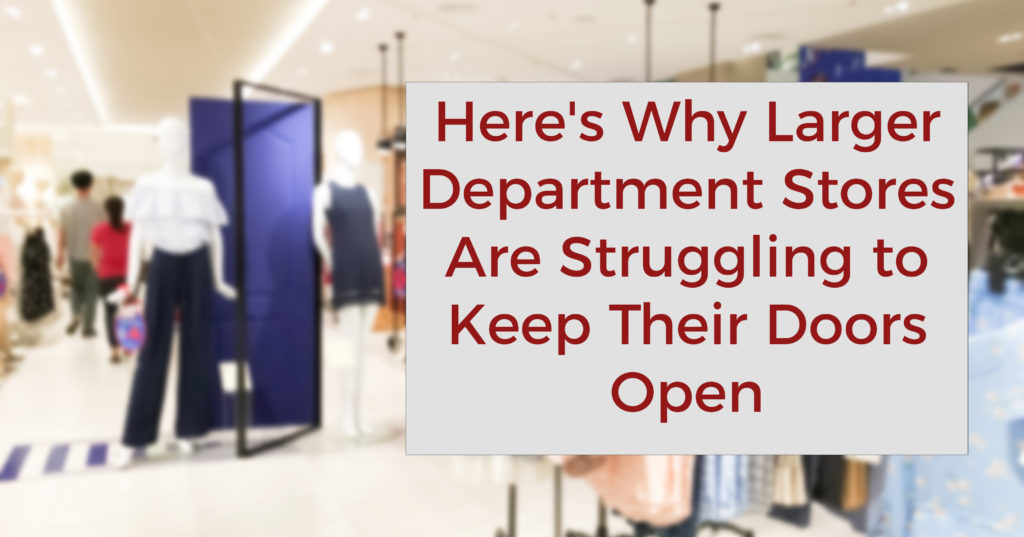News shows department stores closing often.
Learn why some are closing and how some adapt to keep their doors open.
It’s easy to get discouraged when you turn on the news these days. Stories of large department stores closing their doors aren’t uncommon anymore.
Sears is closing 150 stores, according to the latest reports. Macy’s has already begun the shutdown of the 100 stores it said it would close at the end of last year. Many mall stores, such as Aeropostale are also on the verge of shuttering some of their stores.
With all these reports, it begs the question:
Why Are So Many Department Stores Closing?
In answering this question, many people are quick to point a finger at technology. More specifically, online ordering.
It makes sense too. It’s much easier to click a few buttons and place an order from a smartphone than it is to carve out time to get in the car and drive to the closest location.
But there’s one fundamental feature that online ordering hasn’t mastered – instant gratification.
We’re living in a world where everything is at our fingertips. Amazon Prime offers free 2-day shipping and one-click ordering. Although there is a level of gratification in placing an order quickly, the digital retail stores are missing one key ingredient. And perhaps not coincidentally, so are some of the large department stores, which is why they’re shuttering their doors.
The Answer: A Lack of Personalization
Online ordering might be cannibalizing some sales from large department stores, but it’s not the core reason that these retailers are having to shut down hundreds of brick-and-mortar locations.
The reason is a lack of personalization.
Case in point: Amazon
Amazon is a powerhouse in the online retail space. Even with their massive success in the digital world, they’re experimenting with brick-and-mortar stores in major metropolitan areas, including Seattle, Portland, San Diego, and soon, New York City.
The difference in an Amazon store, compared to a large department store, is the experience the consumer will have. Although Amazon has a wide array of products, their goal with their brick-and-mortar store is to simplify the shopping experience and make it more enjoyable for their buyers.
One way they’re doing this is with their grocery chain, Amazon Go, where consumers can take groceries off the shelf and walk out of the store with them, skipping the checkout line all together.
Another Case in Point: Sephora
Sephora, a makeup chain, has also seen high margins, which they credit to their mobile app. Now they’re taking the lessons learned in the digital space and applying them to the in-store experience.
In the app, consumers can try on different shades of eyeliner and lipstick to see what they look like before buying. It’s a fun way to personalize the shopping experience, and one that has yielded the brand some of the highest margins in the industry.
To keep their buyers engaged, Sephora is incorporating this same experience in-store with mirrors that offer the same technology to buyers. They’ll also offer beauty classes and other ways to make the shopping experience a little more enjoyable than pulling a product off a shelf.
What This Means for Your Retail Store
Although big brands are closing their doors, your retail stores have a prime opportunity to grow, but you have to capitalize on it now.
Personalizing every stage of the customer’s experience is easier with today’s technology.
When the buyer walks through the front doors, she is eager to find the right style, fit, and price. The way your shop is set up can make it easier for her to accomplish her goals. For example:
- Put together outfit ideas instead of displaying single pieces alone;
- Set up your displays so it’s easy for the buyer to find what she’s looking for;
- Train your associates to offer upsells and cross-sells to make the shopping experience more personal and enjoyable.
When the buyer is ready to try on her clothes, make it as quick and easy as possible for her to get into a room. Then, once she’s in the room, give her the opportunity to connect with a sales associate for additional items without having to get re-dressed and leave the fitting room.
The fitting room is where the purchase decisions are made and where you can reduce your apparel return rates. Personalize the experience and you’ll see a spike in your profits.
Are You Losing Money Due to a Lack of Personalization?
Do you know where you stand in terms of personalization in your retail store compared to other stores your consumers are buying from? It’s not an easy benchmark to find, but it’s an important one.
We can help you determine these critical benchmarks so you can find opportunities for more personalization and more profits.
